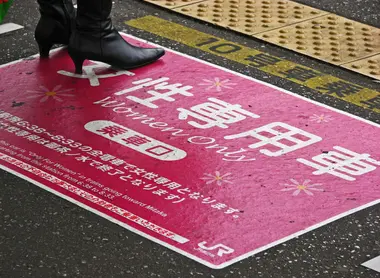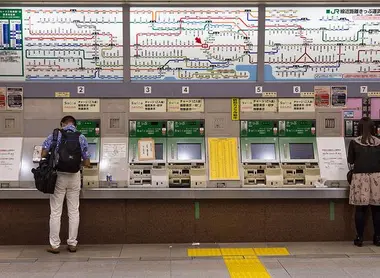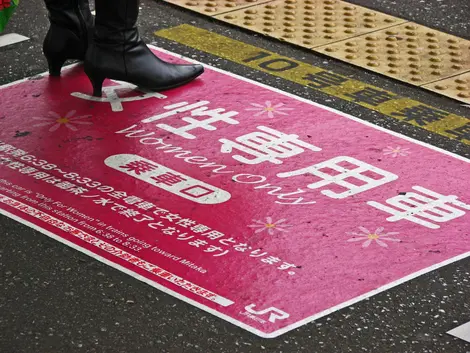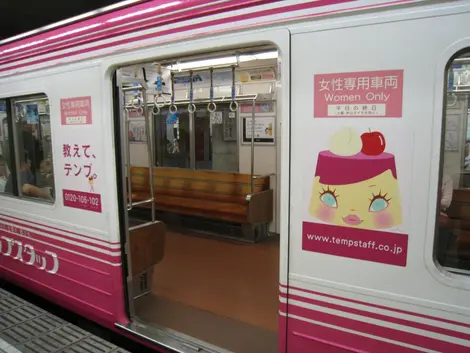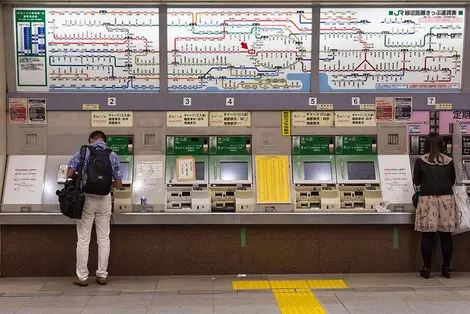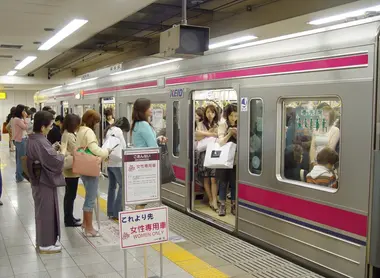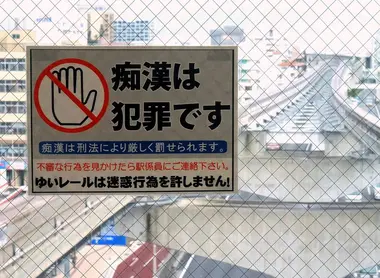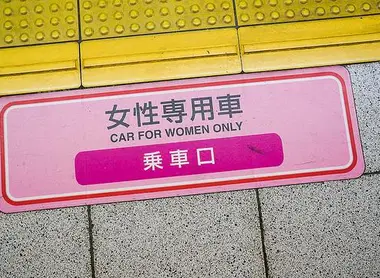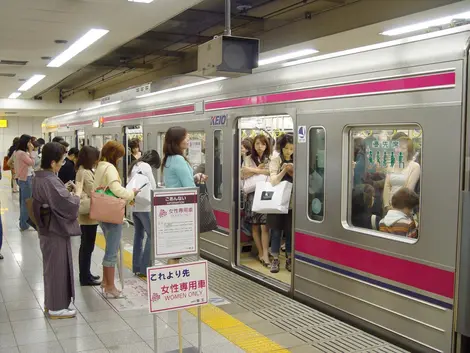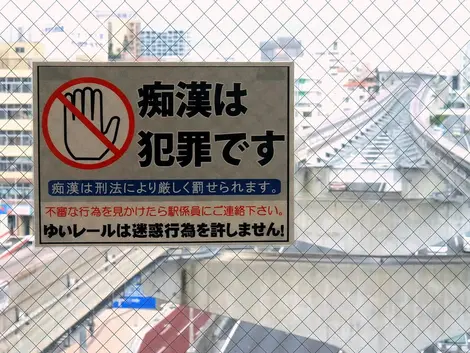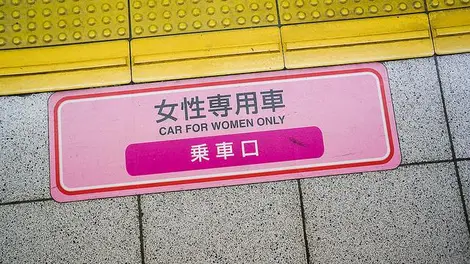Women only cars on trains
- Published on : 14/11/2017
- by : I.D.O.
- Youtube
Women Only
To protect female passengers from unwanted attention when they travel, some Japanese rail companies have started designating women-only cars in their trains.
Train cars for women: a history
As early as 1912, the Tokyo Chuo line introduced women-only cars to separate female students from rush hour students until the Second World War broke out. In 1920, it was Kobe city's turn to reserve entire trams for ladies, while in the 1930s, Hankyu company had trains reserved for schoolgirls who traveled from Kobe to Nishinomiya, a town about fifteen kilometers away. After the Second World War, many railway companies reserved cars for women and children because it was extremely difficult for them to board the crowded trains. These cars were replaced in 1973 by the system of priority seats.
A system to stop perverts
While the cars reserved for women and schoolgirls disappeared in the middle of the twentieth century, travelers with "wandering hands" unfortunately remained. In a survey conducted in the early 2000s by Tokyo Metropolitan Police and JR Railway Company, two-thirds of women aged 20-40 reported being touched, called chikan (a term in Japanese for both the guilty person and the act of touching someone without their consent), in crowded trains. These results prompted some companies to take action and they started to designate whole cars for female rush-hour passengers, or others all day, but only on weekdays. In 2000, the Keio Line, which connects Shinjuku to the dormitory communities of West Tokyo, was one of the first to offer ladies' cars. It first offered this service for late hours and then during evening rush hours on express trains.
In 2001, JR East followed the example of late hours on the Saikyo line, which connects Tokyo to Saitama Prefecture, which was notorious for the many riders who took advantage of the anonymity of the crowds and the long distances between the stations to perpetrate their attacks. The following year, the same system was applied during rush hours in the evening.
Read : Public transport in Japan
In Osaka, since 2002, the Midosuji subway line has had cars reserved for ladies. Carrying passengers at certain times at 160% of its capacity, this line was known as the worst for the chikan problem. The system proved to be very effective (complaints having decreased by a third in just one year), so it was applied on trains all day, and not just at peak hours. The Hankyu line has also followed suit by offering "women only" cars all day long. In 2002, it was the turn of JR WEST company to designate some cars for ladies at rush hour.
Since 2005, most of the companies operating lines in Tokyo have ladies' cars. Some of them also allow access to young boys, the handicapped, and caregivers (male or female) if they are accompanied by a woman.
Signs on the platforms indicate which cars, days and hours they are reserved for women.
Chikan: punishable by law
The chikan problem is taken very seriously by railway companies and the authorities, and anyone found guilty of groping is liable to imprisonment or a fine of up to 500,000 yen ($4,500). Numerous signs in the train stations remind us that groping someone is a crime punishable by law. But like everywhere in the world, most women who are victims of such acts don't dare to react and, if they do it by shouting "chikan!", it's sometimes difficult to stop the culprit, who flees before anyone can stop them.
The opposite problem also occurs: some women have allegedly accused men of having touched them in order to receive monetary compensation. This issue was featured in a 2007 film: "Sore de mo, Boku wa yatte inai" ("I didn't do that") based on the true story of an innocent young man accused of touching a student on a train. Some men have even requested cars reserved for men, so as not to be accused wrongly, and others are offended that all men are treated as potential perverts. But surveys reveal that the majority of passengers - both women and men - are for this system of segregation.

Japonaise sur le quai du métro à Tokyo
Tokyoform
Alternatives et solutions pour lutter contre le harcèlement dans les transports
Face aux limites et aux controverses suscitées par les wagons réservés aux femmes, de nombreuses alternatives sont proposées pour lutter efficacement contre le harcèlement dans les transports en commun :
- Campagnes de sensibilisation : Éduquer le public sur le harcèlement et ses conséquences, encourager les témoins à intervenir.
- Formation du personnel : Former les agents des transports à repérer et à réagir face aux situations de harcèlement.
- Renforcement de la sécurité : Augmenter la présence de personnel de sécurité et de caméras de surveillance dans les transports.
- Systèmes d'alerte : Mettre en place des dispositifs permettant aux victimes de signaler rapidement les agressions, comme le numéro d'urgence 3117 en France.
- Sanctions renforcées : Durcir les peines pour les auteurs de harcèlement et faciliter les procédures de plainte.
- Aménagement des espaces : Concevoir des transports plus ouverts et mieux éclairés pour réduire les opportunités d'agressions.
- Applications mobiles : Développer des outils permettant aux femmes de signaler les zones à risque et de s'entraider.
Ces solutions visent à créer un environnement plus sûr pour tous les usagers, sans pour autant recourir à la ségrégation. Elles s'inscrivent dans une approche globale de lutte contre le harcèlement, impliquant l'ensemble de la société.
En France, par exemple, une campagne de sensibilisation commune a été lancée en 2018 par la Région Île-de-France, Île-de-France Mobilités, la RATP et SNCF Transilien. Cette initiative vise à responsabiliser les voyageurs et à leur rappeler les bons réflexes face au harcèlement. Elle s'accompagne de mesures concrètes comme le renforcement de la présence humaine dans les transports et la généralisation de la vidéoprotection.
L'accent est également mis sur la prévention et l'éducation, notamment auprès des jeunes, pour changer les mentalités sur le long terme. L'objectif est de créer une culture du respect mutuel dans l'espace public, où le harcèlement ne serait plus toléré ni banalisé.
Perspectives d'avenir : vers une généralisation ou un abandon du concept ?
L'avenir des wagons réservés aux femmes reste incertain et dépendra largement de l'évolution des mentalités et de l'efficacité des mesures alternatives mises en place. Plusieurs scénarios sont envisageables :
1. Généralisation limitée : Le concept pourrait se maintenir et même s'étendre dans certains pays où le harcèlement reste un problème majeur, tout en étant considéré comme une solution temporaire en attendant des changements sociétaux plus profonds.
2. Abandon progressif : À mesure que d'autres solutions se révèlent efficaces et que la sensibilisation au harcèlement progresse, les wagons réservés pourraient être progressivement supprimés, comme ce fut le cas dans certaines villes.
3. Évolution du concept : Plutôt que des wagons exclusivement féminins, on pourrait voir émerger des espaces "sûrs" ouverts à tous, mais sous surveillance renforcée.
4. Approche hybride : Certains pays pourraient opter pour un système flexible, avec des wagons réservés uniquement à certaines heures ou sur certaines lignes jugées plus à risque.
La tendance actuelle semble plutôt s'orienter vers la recherche de solutions inclusives qui ne reposent pas sur la séparation des sexes. L'accent est mis sur la responsabilisation de tous les usagers et la création d'un environnement sûr pour chacun, indépendamment du genre.
En France, par exemple, l'idée de wagons réservés aux femmes n'a pas été retenue, au profit d'une approche globale de lutte contre le harcèlement. Les autorités misent sur la sensibilisation, la formation du personnel, le renforcement de la sécurité et l'amélioration des dispositifs d'alerte.
L'enjeu pour l'avenir sera de trouver un équilibre entre la protection immédiate des femmes et la construction d'une société plus égalitaire à long terme. Cela passera nécessairement par un changement des mentalités et une prise de conscience collective de l'importance du respect mutuel dans l'espace public.
En définitive, quelle que soit l'évolution du concept de wagons réservés aux femmes, l'objectif reste le même : permettre à chacun, homme ou femme, de voyager en toute sérénité, sans crainte d'être harcelé ou agressé. C'est un défi qui concerne l'ensemble de la société et qui nécessitera des efforts soutenus sur le long terme.
Pour aller plus loin dans la compréhension des enjeux liés aux transports en commun au Japon, pays pionnier en matière de wagons réservés aux femmes, n'hésitez pas à consulter notre article sur les mots à connaître pour prendre le train au Japon. Si vous prévoyez un voyage à Tokyo, vous trouverez également des informations utiles dans notre guide pour utiliser le métro à Tokyo.
